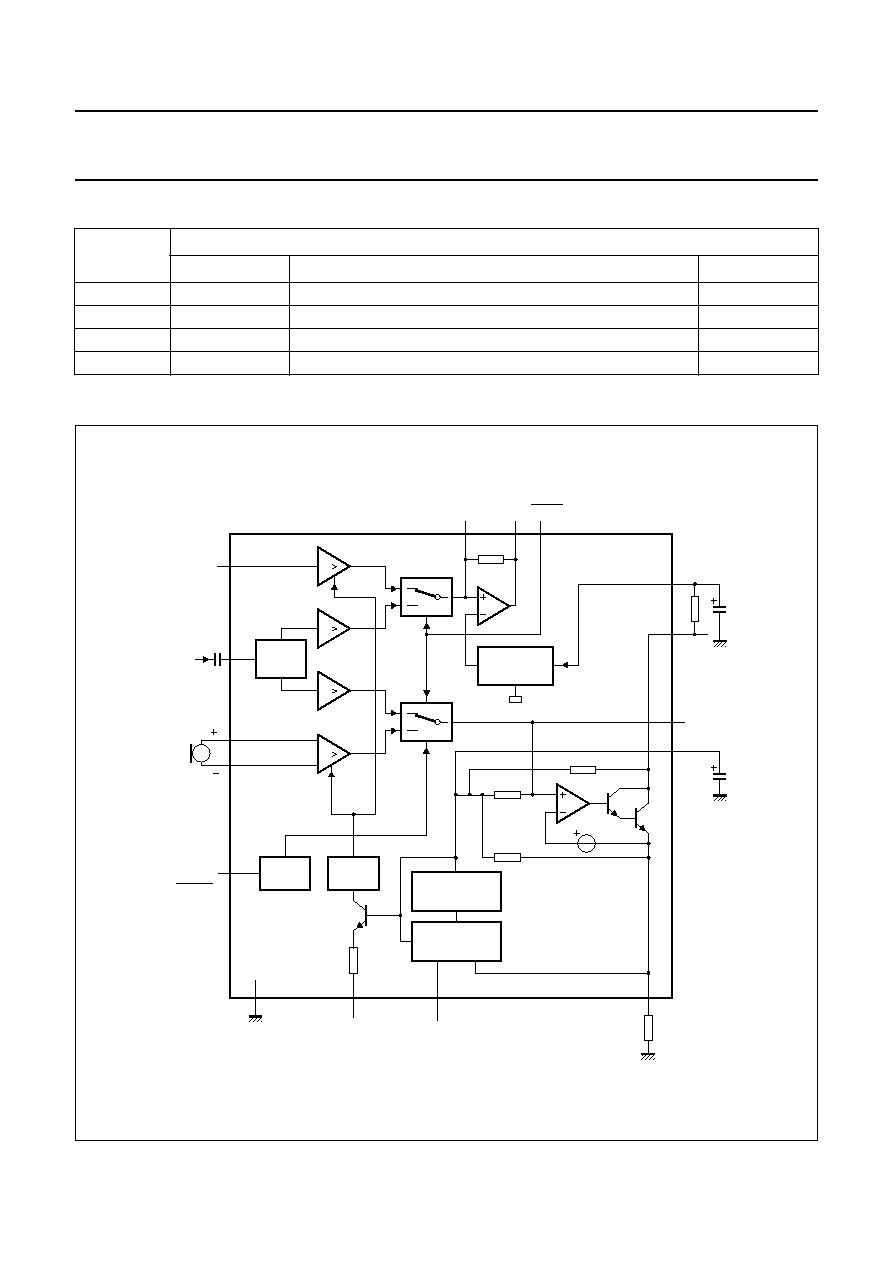Low voltage versatile telephone transmission circuits with dialler interface

DATA SHEET
Product specification
Supersedes data of 1996 Feb 16
File under Integrated Circuits, IC03
1997 Mar 26
INTEGRATED CIRCUITS
TEA1112; TEA1112A
Low voltage versatile telephone
transmission circuits with dialler
interface

1997 Mar 26
2
Philips Semiconductors
Product specification
Low voltage versatile telephone
transmission circuits with dialler interface
TEA1112; TEA1112A
FEATURES
·
Low DC line voltage; operates down to 1.6 V (excluding
polarity guard)
·
Voltage regulator with adjustable DC voltage
·
Provides a supply for external circuits
·
Symmetrical high impedance inputs (64 k
) for
dynamic, magnetic or piezo-electric microphones
·
Asymmetrical high impedance input (32 k
) for electret
microphones
·
DTMF input with confidence tone
·
Mute input for pulse or DTMF dialling (MUTE for
TEA1112 and MUTE for TEA1112A)
·
Receiving amplifier for dynamic, magnetic or
piezo-electric earpieces
·
AGC line loss compensation for microphone and
earpiece amplifiers
·
LED on-hook/off-hook status indication
·
Microphone mute function (MMUTE for TEA1112 and
MMUTE for TEA1112A).
APPLICATION
·
Line powered telephone sets, cordless telephones, fax
machines and answering machines.
GENERAL DESCRIPTION
The TEA1112; TEA1112A are bipolar integrated circuits
that perform all speech and line interface functions
required in fully electronic telephone sets. They perform
electronic switching between speech and dialling. The ICs
operate at a line voltage down to 1.6 V DC (with reduced
performance) to facilitate the use of telephone sets
connected in parallel.
A current (proportional to the line current and internally
limited to a typical value of 19.5 mA) is available to drive
an LED which indicates the on-hook/off-hook status.
The microphone amplifier can be disabled during speech
condition by means of a microphone mute function.
All statements and values refer to all versions unless
otherwise specified.
QUICK REFERENCE DATA
I
line
= 15 mA; V
EE
= 0 V; R
SLPE
= 20
; AGC pin connected to V
EE
; Z
line
= 600
; f = 1 kHz; T
amb
= 25
°
C;
unless otherwise specified.
SYMBOL
PARAMETER
CONDITIONS
MIN.
TYP.
MAX.
UNIT
I
line
line current operating range
normal operation
11
-
140
mA
with reduced performance
1
-
11
mA
I
LED(max)
maximum supply current available
I
line
= 18 mA
-
0.5
-
mA
I
line
> 76 mA
-
19.5
-
mA
V
LN
DC line voltage
3.35
3.65
3.95
V
I
CC
internal current consumption
V
CC
= 2.9 V
-
1.15
1.4
mA
V
CC
supply voltage for peripherals
I
p
= 0 mA
-
2.9
-
V
G
vtrx
typical voltage gain range
microphone amplifier
V
MIC
= 2 mV (RMS)
38.8
-
51.8
dB
receiving amplifier
V
IR
= 6 mV (RMS)
19.2
-
31.2
dB
G
vtrx
gain control range for microphone and
receiving amplifiers with respect to
I
line
= 15 mA
I
line
= 85 mA
-
5.8
-
dB
G
vtxm
microphone amplifier gain reduction
-
80
-
dB

1997 Mar 26
3
Philips Semiconductors
Product specification
Low voltage versatile telephone
transmission circuits with dialler interface
TEA1112; TEA1112A
ORDERING INFORMATION
BLOCK DIAGRAM
TYPE
NUMBER
PACKAGE
NAME
DESCRIPTION
VERSION
TEA1112
DIP16
plastic dual in-line package; 16 leads (300 mil)
SOT38-4
TEA1112A
DIP16
plastic dual in-line package; 16 leads (300 mil)
SOT38-4
TEA1112T
SO16
plastic small outline package; 16 leads; body width 3.9 mm
SOT109-1
TEA1112AT
SO16
plastic small outline package; 16 leads; body width 3.9 mm
SOT109-1
Fig.1 Block diagram.
handbook, full pagewidth
ATT.
DTMF
V
-
I
MICRO
MUTE
AGC
CIRCUIT
CURRENT
REFERENCE
LOW VOLTAGE
CIRCUIT
LED
DRIVER
IR
MIC
MIC
MMUTE
or
MMUTE
VEE
ILED
AGC
SLPE
TEA1112
TEA1112A
5
4
2
3
10
13
11
6
12
15
14
8
16
1
7
9
GAS
GAR
QR
LN
VCC
REG
MUTE
or
MUTE
V
-
I
V
-
I
V
-
I
MBE793

1997 Mar 26
4
Philips Semiconductors
Product specification
Low voltage versatile telephone
transmission circuits with dialler interface
TEA1112; TEA1112A
PINNING
SYMBOL
PIN
DESCRIPTION
TEA1112
TEA1112A
LN
1
1
positive line terminal
SLPE
2
2
slope (DC resistance) adjustment
I
LED
3
3
available output current to drive a LED
REG
4
4
line voltage regulator decoupling
GAS
5
5
sending gain adjustment
MMUTE
6
-
microphone mute input
MMUTE
-
6
microphone mute input (active LOW)
DTMF
7
7
dual-tone multi-frequency input
MUTE
8
-
mute input to select speech or dialling mode
MUTE
-
8
mute input to select speech or dialling mode (active LOW)
IR
9
9
receiving amplifier input
AGC
10
10
automatic gain control/line loss compensation
MIC
-
11
11
inverting microphone amplifier input
MIC+
12
12
non-inverting microphone amplifier input
V
EE
13
13
negative line terminal
QR
14
14
receiving amplifier output
GAR
15
15
receive gain adjustment
V
CC
16
16
supply voltage for speech circuit and peripherals
Fig.2 Pin configuration (TEA1112).
handbook, halfpage
TEA1112
MBE791
1
2
3
4
5
6
7
8
16
15
14
13
12
11
10
9
VCC
GAR
QR
VEE
MIC
+
MIC
-
AGC
IR
LN
SLPE
ILED
REG
GAS
MMUTE
DTMF
MUTE
Fig.3 Pin configuration (TEA1112A).
handbook, halfpage
TEA1112A
MBE790
1
2
3
4
5
6
7
8
16
15
14
13
12
11
10
9
VCC
GAR
QR
VEE
MIC
+
MIC
-
AGC
IR
LN
SLPE
ILED
REG
GAS
MMUTE
DTMF
MUTE

1997 Mar 26
5
Philips Semiconductors
Product specification
Low voltage versatile telephone
transmission circuits with dialler interface
TEA1112; TEA1112A
FUNCTIONAL DESCRIPTION
All data given in this chapter are typical values, except
when otherwise specified.
Supply (pins LN, SLPE, V
CC
and REG)
The supply for the TEA1112; TEA1112A and their
peripherals is obtained from the telephone line.
The ICs generate a stabilized reference voltage (V
ref
)
between pins LN and SLPE. This reference voltage is
equal to 3.35 V, is temperature compensated and can be
adjusted by means of an external resistor (R
VA
). It can be
increased by connecting the R
VA
resistor between
pins REG and SLPE (see Fig.5), or decreased by
connecting the R
VA
resistor between pins REG and LN.
The voltage at pin REG is used by the internal regulator to
generate the stabilized reference voltage and is decoupled
by a capacitor (C
REG
) which is connected to V
EE
. This
capacitor, converted into an equivalent inductance (see
Section "Set impedance"), realizes the set impedance
conversion from its DC value (R
SLPE
) to its AC value (R
CC
in the audio-frequency range). The voltage at pin SLPE is
proportional to the line current. Figure 4 illustrates the
supply configuration.
The ICs regulate the line voltage at pin LN, and can be
calculated as follows:
V
LN
V
ref
R
SLPE
I
SLPE
×
+
=
I
SLPE
I
line
I
CC
I
p
I
I
LED
I
+
sh
=
=
Where:
I
line
= line current
I
CC
= current consumption of the IC
I
p
= supply current for peripheral circuits
I* = current consumed between LN and V
EE
I
LED
= supply current for the LED component
I
sh
= the excess line current shunted to SLPE (and V
EE
)
via LN.
The preferred value for R
SLPE
is 20
. Changing R
SLPE
will
affect more than the DC characteristics; it also influences
the microphone and DTMF gains, the LED supply current
characteristic, the gain control characteristics, the
sidetone level and the maximum output swing on the line.
The internal circuitry of the TEA1112; TEA1112A is
supplied from pin V
CC
. This voltage supply is derived from
the line voltage by means of a resistor (R
CC
) and must be
decoupled by a capacitor C
VCC
. It may also be used to
supply peripheral circuits such as dialling or control
circuits. The V
CC
voltage depends on the current
consumed by the IC and the peripheral circuits as shown
by the formula (see also Figs.6 and 7). R
CCint
is the
internal impedance of the voltage supply point, and I
rec
is
the current consumed by the output stage of the earpiece
amplifier.
V
CC
V
CC0
R
CCint
I
p
I
rec
(
)
×
=
V
CC0
V
LN
R
CC
I
CC
×
=
Fig.4 Supply configuration.
handbook, full pagewidth
LED
DRIVER
Ish
Rp
Rd
ISLPE
REG
LN
RGASint
from pre amp
SLPE
45.5 k
15.5 k
VEE
Vd
VCC
RCC
CVCC
ICC
CREG
RSLPE
Vexch
Rexch
ILED
ILED
Iline
Rline
TEA1112
TEA1112A
I
*
IP
peripheral
circuits
100
µ
F
4.7
µ
F
20
69 k
619
MBE789
Document Outline
- FEATURES
- APPLICATION
- GENERAL DESCRIPTION
- QUICK REFERENCE DATA
- ORDERING INFORMATION
- BLOCK DIAGRAM
- PINNING
- FUNCTIONAL DESCRIPTION
- Supply (pins LN, SLPE, VCC and REG)
- Set impedance
- LED supply (pin ILED )
- Microphone amplifier (pins MIC+, MIC- and GAS)
- Microphone mute (pin MMUTE; TEA1112)
- Microphone mute (pin MMUTE; TEA1112A)
- Receiving amplifier (pins IR, GAR and QR)
- Automatic gain control (pin AGC)
- Mute function (pin MUTE; TEA1112)
- Mute function (pin MUTE; TEA1112A)
- DTMF amplifier (pin DTMF)
- MUTE and MMUTE levels for different modes
- SIDETONE SUPPRESSION
- LIMITING VALUES
- THERMAL CHARACTERISTICS
- CHARACTERISTICS
- APPLICATION INFORMATION
- PACKAGE OUTLINES
- SOLDERING
- DEFINITIONS
- LIFE SUPPORT APPLICATIONS




